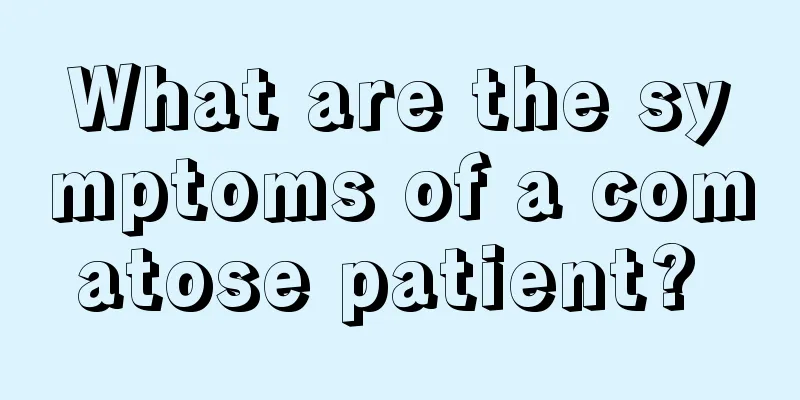What are the symptoms of a comatose patient?

|
Coma is a relatively dangerous symptom. During the coma period, the patient will be unconscious and unable to perceive external stimuli. In more serious cases, his or her vital signs will gradually disappear, seriously threatening the patient's life safety. Therefore, when a patient is in a coma, the first thing to do is to determine the type of coma the patient has, that is, whether the patient's coma is a light coma or a deep coma, whether it is syncope or cardiac arrest. Only by determining these can we take appropriate rescue measures based on the actual situation. Otherwise, if the judgment is wrong, it will not only waste the rescuer's energy, but also delay the patient's best treatment period. So, what are the symptoms of a comatose patient? The analysis will be given below! 1. Detailed introduction to coma symptoms Clinically, there are roughly three types of complete loss of consciousness, namely coma, syncope and cardiac arrest. Syncope is a brief loss of consciousness, and the patient usually regains consciousness within a few minutes. Cardiac arrest is the most serious condition, a state called "clinical death". If the patient is not rescued within minutes, irreversible biological death will occur. Therefore, when loss of consciousness occurs, it is necessary to immediately identify whether the patient is in a coma, syncope or cardiac arrest. For the latter, cardiopulmonary resuscitation must be performed immediately on the spot to save the patient's life. 2. Symptoms of patients in mild coma In a mild coma, there is loss of voluntary movement with only a few unconscious spontaneous movements. The patient will have an avoidance reaction and a painful expression in response to painful stimuli (such as compression of the supraorbital margin), but will be unable to answer questions or execute simple commands. Swallowing reflex, cough reflex, corneal reflex, pupillary light reflex, and tendon reflex still exist, and there is no obvious change in vital signs. May be accompanied by delirium and agitation. 3. Symptoms of patients in deep coma In deep coma, spontaneous movements completely disappear, muscles relax, and there is no response to external stimuli. Corneal reflex, pupillary reflex, cough reflex, swallowing reflex and tendon reflexes. Irregular breathing disappeared and blood pressure dropped. That is, various reactions and reflexes disappear, pathological signs continue to exist or disappear, and there may be changes in vital signs. Coma is a sign of a serious illness and the cause should be actively sought and treated. |
<<: What are the causes of aortic calcification?
>>: How to care for patients with cerebral hemorrhage?
Recommend
TSH value control range after hemisection of thyroid cancer
Hemisection of thyroid cancer refers to a hemisec...
What to do if rhinitis is severe in the morning and evening
When people suffer from many diseases, they are m...
Quick relief of cervical spondylosis headache
For people with cervical spondylosis, their lives...
Can I drink yeast grass during my period?
We are all familiar with menstruation, which is w...
What are the symptoms of skin graft necrosis
When human skin is damaged, a surgery called skin...
Put this food in the microwave and the whole family will be buried alive!
Microwave ovens are used very frequently in our d...
7 foods recommended for spring health care to soothe qi and nourish the liver
Spring has already arrived. Are you still worried...
The effect of vinegar on the liver
I believe that everyone comes into contact with v...
Does taking a nap help you grow taller?
Some people will feel that they want to grow tall...
Nursing for bleeding after bladder cancer surgery
Bleeding is a common and serious complication aft...
Are pubic lice parasites? Here are five points to tell you
Pubic lice is a type of lice that is transmitted ...
How should kidney deficiency be treated? Treatment for kidney deficiency
In traditional Chinese medicine, kidney deficienc...
What is the survival rate of rectal cancer
The survival rate for rectal cancer in its early ...
What are the stage symptoms of dilated cardiomyopathy?
As the name suggests, dilated cardiomyopathy caus...
What are the causes of spots on the face? There are three reasons
In daily life, we often see some people with spot...









